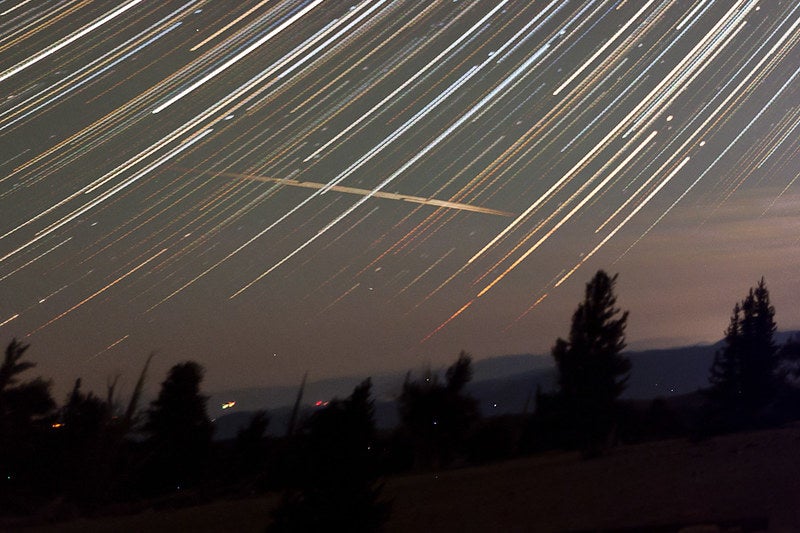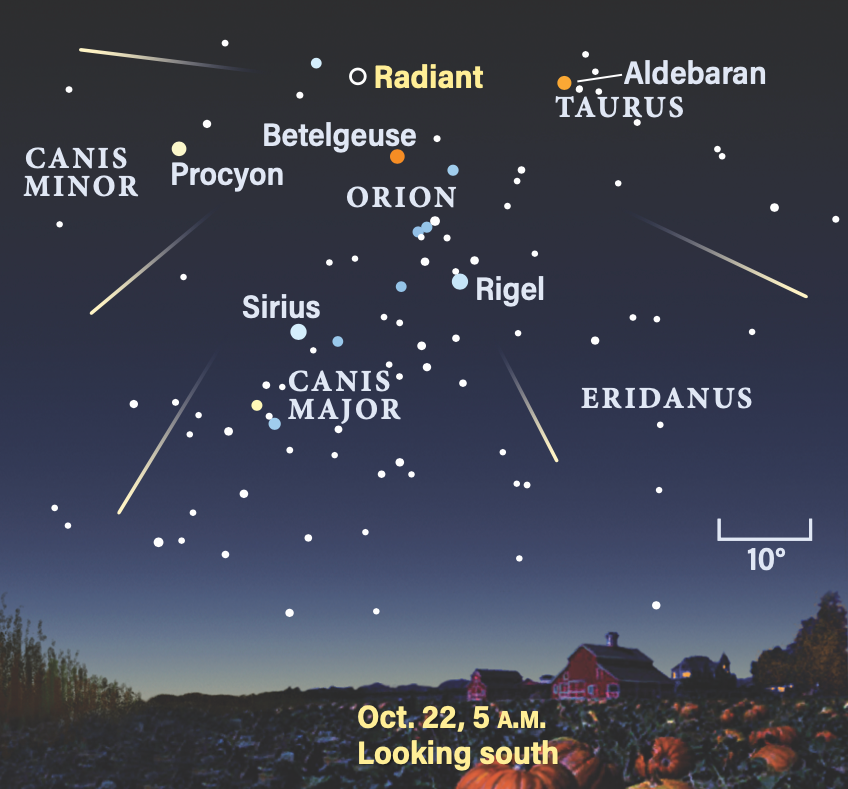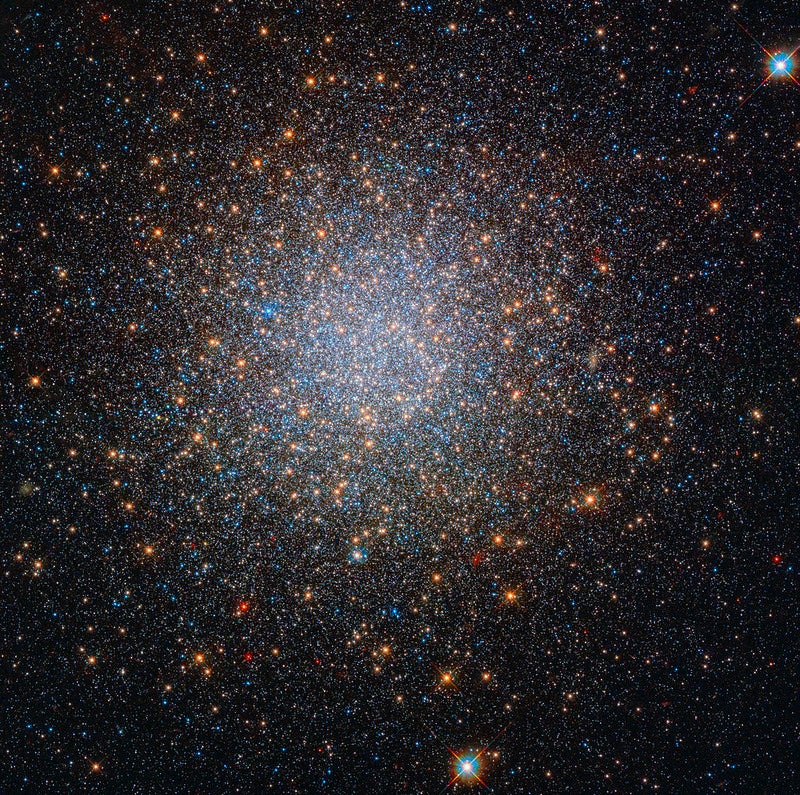
Friday, October 20
The solar system’s smallest planet, Mercury, reaches superior conjunction at 2 A.M. EDT. Not currently observable, the planet will become an evening star visible after sunset in November.
With the Moon setting around 10:30 P.M. local daylight time, let’s use the dark window tonight to view one of the most famous disaster sites in the sky: M1, the Crab Nebula. Located in Taurus and about 20° high by 11 P.M., the Crab is what’s left of a massive star that exploded at the end of its life in the year 1054. Now, the remnants of that star are visible as a wispy nebula, at the center of which lies a rapidly rotating neutron star.
You can find the Crab just over 1° northwest of 3rd-magnitude Zeta (ζ) Tauri at the tip of the Bull’s southern horn. Spanning about 6′ by 4′, the Crab glows softly at magnitude 8.4 and typically appears as a whitish smudge on the sky, like a thumbprint. However, that thumbprint is getting larger as it expands over time, and the material within it has been clocked at more than 620 miles (1,000 kilometers) per second. If you have a large scope, you might even be able to pick up the nebula’s central pulsar at magnitude 16.2.
Sunrise: 7:16 A.M.
Sunset: 6:13 P.M.
Moonrise: 1:35 P.M.
Moonset: 10:22 P.M.
Moon Phase: Waxing crescent (34%)
*Times for sunrise, sunset, moonrise, and moonset are given in local time from 40° N 90° W. The Moon’s illumination is given at 12 P.M. local time from the same location.

Saturday, October 21
Tonight is International Observe the Moon Night, a celebration of Earth’s natural satellite. Luna reaches First Quarter at 11:29 P.M. EDT, offering great opportunities for observing as twilight falls. The Moon is now in Sagittarius, high in the south at sunset and following the Teapot asterism slowly down toward the southwestern horizon until it sets about 30 minutes before local midnight.
Look first for the terminator, the line dividing the dark and light areas of the Moon. This is also the place where sunrise is occurring as lunar day begins and ever more of the nearside is illuminated. Near the equator are the Apennine Mountains, named after the same range on Earth. To the mountains’ north are the craters Archimedes, Autolycus, and Aristillus. The Sun angle allows us to see how the material excavated from each hit lays spattered across the surrounding terrain, offering a visual representation of lunar history right before your eyes. Also check out the way their high walls are lit by the Sun, but the crater floors remain in shadow for another day or two as the slow lunar sunrise creeps over the surface. Day and night on the Moon are each two weeks long, so sunrise and sunset are accordingly longer as well. If you watch for several hours, you can see the shadows change as the Sun rises higher in the sky from the craters’ perspective.
South of the equator are many more craters to enjoy, including Albategnius and Hipparchus. These are older than the three northern examples, with less-obvious aprons of ejecta and clear signs of battering by smaller impactors over their lifetimes.
The Orionid meteor shower peaks overnight tonight; the best viewing will be early tomorrow morning, though you can catch Orion rising in the east just before midnight. The Hunter clears the horizon around 11 P.M. local daylight time, carrying the radiant for this fall favorite meteor shower just above his shoulders. Check out tomorrow’s entry for more details on how to enjoy the Orionids.
Sunrise: 7:17 A.M.
Sunset: 6:12 P.M.
Moonrise: 2:27 P.M.
Moonset: 11:33 P.M.
Moon Phase: Waxing crescent (45%)

Sunday, October 22
The best time to view the Orionid meteor shower is in the early-morning hours today between about 2 A.M. local daylight time and local sunrise. That’s because during this time, the constellation Orion the Hunter is rising ever higher in the east, improving your chances for seeing more and more meteors generated by this stream.
The Orionids originate from debris left behind by Halley’s Comet. As the comet passed through our inner solar system and rounded the Sun, it left a trail of dust that Earth now passes through twice a year. The Eta Aquariid meteor shower in spring is also caused by this same trail of debris.
Orionid meteors originate from a radiant just northeast of the red giant star Betelgeuse, one of the Hunter’s shoulders. The best views will come from about 45° on either side of this point, so look a little north or south of Orion once you locate the constellation in the eastern sky. These spots are where the glowing trains left by meteors will be longest. You can expect to see some 15 to 20 meteors per hour this morning before sunrise, or one every few minutes. The best way to enjoy the show is to get out under a dark sky where you have a clear view of the northern, eastern, and southern horizon. Then, simply stand or sit and scan the sky for shooting stars, no equipment needed. Astrophotographers can use the chance to image both the landscape and the sky, catching the occasional meteor as it streaks through the shot against the background stars.
Rates should improve as dawn approaches, though the brightening sky will start to wash out fainter meteors as well.
Sunrise: 7:18 A.M.
Sunset: 6:10 P.M.
Moonrise: 3:10 P.M.
Moonset: —
Moon Phase: Waxing gibbous (57%)
Monday, October 23
Venus reaches greatest western elongation (46°) at 7 P.M. EDT. This is also the moment when the planet reaches dichotomy, or becomes exactly 50 percent lit; however, due to several effects, it may appear to be not quite half lit for several more days. Take a look at it each morning for the next few days and compare its appearance — when do you think it appears exactly half lit?
Venus is currently a morning star, rising several hours before the Sun and standing some 30° high an hour before sunrise. It’s located in Leo, near the back paws of the Lion, and blazingly bright at magnitude –4.5. The planet is also not far from the famous Leo Triplet of galaxies, which are just under 9° northeast of bright Venus this morning.
If you want to observe this trio, make it a slightly earlier morning and get outside about two hours before sunrise. The darker background sky will better aid with seeing these three spiral galaxies, which range from magnitude 8.9 to 9.5, so you’ll definitely want a scope to spot them.
Let’s start with the brightest of the group, M66. This galaxy is roughly twice as long as it is wide, spanning some 8′ along its long axis (which is oriented north-south). You may be able to spot the central brightening that marks its nucleus. Some 0.3° northwest of M66 is M65, slightly fainter at magnitude 9.3 and also oriented roughly north-south. This galaxy is much more elongated, almost 9′ on its long axis but only 3′ wide.
Finally, swing about 0.5° northeast of M65 to the faintest member, NGC 3628, which lies nearly edge-on and has a dust lane bisecting its glow, further cutting its light. If you’re familiar with the Cigar Galaxy (M82), the two look similar. The plane of NGC 3628 appears oriented roughly east-west and is nearly 14′ at its longest, and 4′ at its widest.
Sunrise: 7:19 A.M.
Sunset: 6:09 P.M.
Moonrise: 3:45 P.M.
Moonset: 12:49 A.M.
Moon Phase: Waxing gibbous (68%)
Tuesday, October 24
The Moon passes 3° south of magnitude 0.6 Saturn at 4 A.M. EDT, though both have set well before this time. Instead, you can catch them shortly after midnight on the 23rd, in the early morning hours of the 24th. Then, they are still 20° high in the southwest, sinking toward the horizon in southwestern Aquarius.
At this time, the Moon is just under 5° south-southwest of Saturn; our satellite will slowly move eastward until it is due south of the planet later in the morning. Zoom in on Saturn itself with a telescope and you’ll enjoy its stunning rings, which currently show off their northern side. The planet’s brightest moon, Titan, may be the only satellite visible with Earth’s Moon so nearby. Titan sits about 2.5′ west-northwest of Saturn tonight.
Much higher in the southern sky around midnight is mighty Jupiter. The gas giant is magnitude –2.9, an unmissable bright point of light in the otherwise dim constellation Aries. Early in the morning, in the few hours after midnight on the 23rd, Callisto lies far east of the planet, with Ganymede slightly closer and Europa closing in on the eastern limb; Io sits alone to the planet’s west. Minutes before 5:30 A.M. EDT this morning, Europa’s shadow slips onto the cloud tops, followed by the moon around 6 A.M. EDT. Observers across the U.S. can watch both move from east to west across the planet’s southern regions. Whether you can view the entire transit of both shadow and Moon will depend on your location and the time of local sunrise (note the time below is given for the Midwest). The shadow disappears around 6:40 A.M. CDT, while Europa slips away from the limb just minutes before sunrise in the Midwest, while the western half of the U.S. is still in darkness.
Sunrise: 7:20 A.M.
Sunset: 6:08 P.M.
Moonrise: 4:14 P.M.
Moonset: 2:05 A.M.
Moon Phase: Waxing gibbous (78%)
Wednesday, October 25
Looking back to Aquarius, the Moon now passes 1.5° south of Neptune at 9 P.M. EDT — this event is visible, as the pair are still high in the south at that time from locations where the sky is already dark. Magnitude 7.7 Neptune is in Pisces, just over that constellation’s border with Aquarius, where the Moon sits. The distant ice giant cannot be seen without binoculars or a telescope to view its 2″-wide disk. It is located just 13′ west of a much fainter 12th-magnitude field star.
Two hours later, the Moon reaches perigee, the closest point to Earth in its orbit, at 11:02 P.M. EDT. Our satellite will then be 226,721 miles (364,872 km) away.
Although the Moon’s bright light will wash out the surrounding sky, the brightest stars will remain visible, including those that form the Great Square of Pegasus to the north of the Moon-Neptune pair. These are, starting at the southeasternmost star and moving clockwise, magnitude 2.8 Algenib, magnitude 2.1 Alpheratz, magnitude 2.4 Scheat, and magnitude 2.5 Markab. Alpheratz is actually in Andromeda, not Pegasus, though that’s likely the result of the two constellations’ more modern boundaries. The late stellar astronomer Jim Kaler noted this star’s name translates to either “the horse’s shoulder” or “the horse’s naval,” both indicating it once formally belonged to the Winged Horse.
Sunrise: 7:21 A.M.
Sunset: 6:06 P.M.
Moonrise: 4:40 P.M.
Moonset: 3:22 A.M.
Moon Phase: Waxing gibbous (87%)
Thursday, October 26
Comet C/2023 H2 (Lemmon) has brightened quickly as it approaches a close pass of Earth next month at a distance of just 18.5 million miles (30 million km). Currently flying beneath the curved handle of the Big Dipper, Lemmon is highest in the early-morning hours before sunrise and was recently observed around magnitude 9, somewhat exceeding expectations for this point it its orbit. The comet is expected to brighten another 1.5 magnitudes to 7.5 before fading quickly again, though perhaps it will brighten even more. We’ll have to wait and see!
To look for Lemmon, step outside anytime after about 5 A.M. local daylight time, while the sky is still dark. Look north, where you’ll see the Big Dipper standing upright on the end of its handle. The second star from the end, right where the handle kinks, is the famous naked-eye double of Mizar and Alcor; these two stars are our guide to the comet this morning. From this pair, swing binoculars or a telescope about 6° south-southwest to land smack dab on Lemmon.
The comet’s coma currently looks mostly spherical, but a long, thin tail appears in photographs. Cameras can also more easily pick up the green glow of that coma, generated by diatomic carbon.
Right now, Lemmon is moving rapidly, traveling northeastward against the background stars. It’s headed for a close pass of Alkaid, the star at the end of the Big Dipper’s handle, the day before Halloween.
Sunrise: 7:22 A.M.
Sunset: 6:05 P.M.
Moonrise: 5:05 P.M.
Moonset: 4:36 A.M.
Moon Phase: Waxing gibbous (94%)

Friday, October 27
The gibbous Moon is setting in the west about an hour and a half before sunrise. As it does so, it leaves a short dark window for observing — let’s use it this morning to look toward Lynx, a somewhat lesser-known constellation now high in the east, just to the left (northeast) of the two heads of Gemini, Castor and Pollux.
Lynx doesn’t house any Messier objects, but it does have one interesting oddball: the globular cluster NGC 2419, also known as the Intergalactic Wanderer. This is one of the farthest globular clusters visible in the Milky Way, some 300,000 light-years away. Its name arises from that vast distance, as it lies as far from our galaxy as the Large Magellanic Cloud. However, because it’s so intrinsically luminous, we still see this globular at a magnitude of 10.4, well within reach of a medium-sized scope. It’s located about 7° north of Castor, Gemini’s alpha star and itself an interesting target as a binary star whose components are nearly equal brightness. Even in a small telescope, these suns are easy to split.
As for the Intergalactic Wanderer, this cluster spans just 4′ and shows off a bright, compact core that might be visible in a small scope; larger scopes will certainly show it better, and perhaps start to resolve some of the few stars visible around the edges. Astrophotos show off its mottled blue and orange appearance; this cluster has been found to house two very different populations of stars, not at all typical for a globular.
Sunrise: 7:24 A.M.
Sunset: 6:04 P.M.
Moonrise: 5:31 P.M.
Moonset: 5:51 A.M.
Moon Phase: Waxing gibbous (98%)

Sky This Week is brought to you in part by Celestron.









